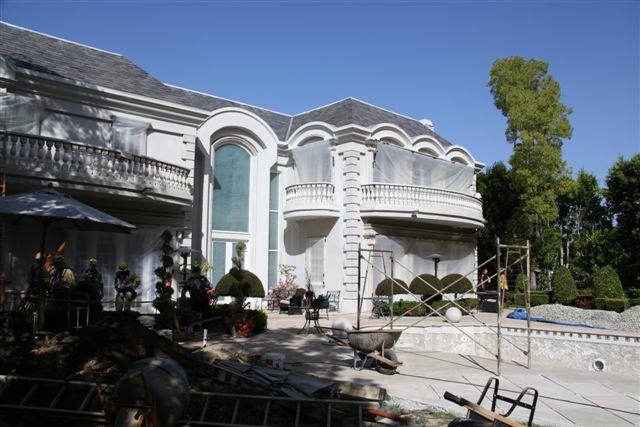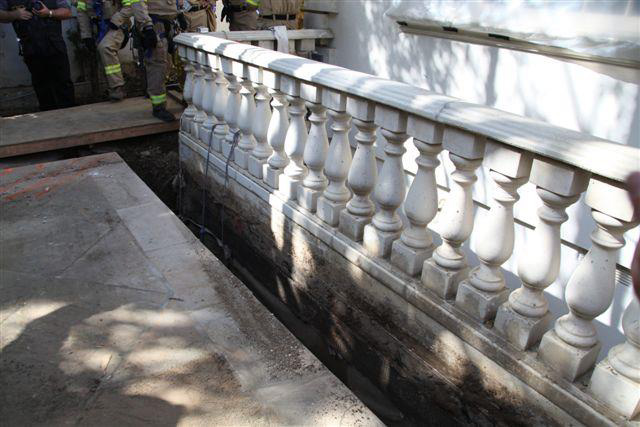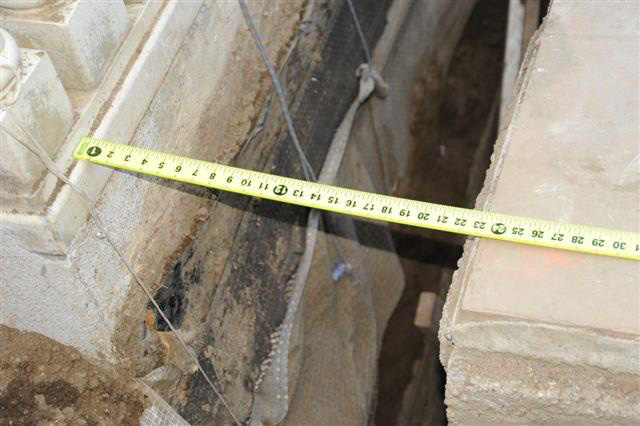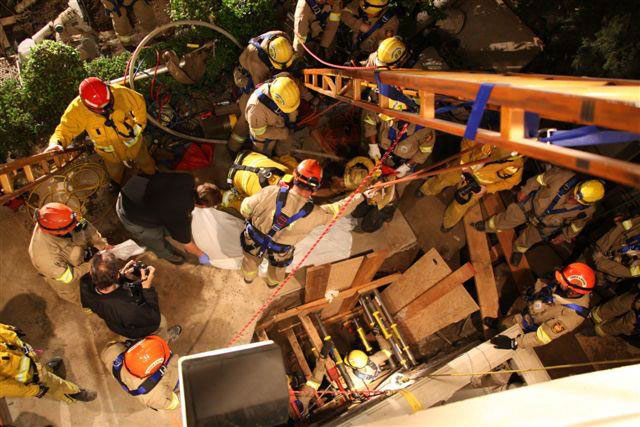Case Report: 12CA004
Day laborer dies when he is buried in a trench collapse
Download a PDF to print this report:
Day laborer dies when he is buried in a trench collapse (12CA004, PDF)
Summary
A day laborer died when he was buried in a trench collapse at a private residence. The homeowner hired day laborers to do construction work at her residence, which included digging trenches along the perimeter of the home for drainage. The trench ranged in depth from 6- to 12-feet deep, and measured 2 feet wide and approximately 15 feet long. None of the permits required to excavate the trench had been obtained and the trench had not been inspected or shored. The employees were not given any training in trench safety and shoring procedures. Factors that may have contributed to this death were untrained workers in an unshored trench more than five feet deep with unstable soil conditions. The CA/FACE investigator determined that, in order to prevent future incidents:
Homeowners who need trenching / excavation work should:
- Hire contractors who are licensed to perform trenching and excavation work.
Contractors licensed to perform trenching should:
- Ensure that the trench is properly permitted and inspected daily by a competent person to determine all necessary safety precautions.
- Ensure that trenches five feet deep or greater are properly shored, shielded, or sloped.
In addition, employers who hire day laborers to work in a trench /excavation should:
- Ensure that day laborers are properly trained and understand all the hazards associated with working in a trench / excavation.
Introduction
On Thursday, May 10, 2012, at approximately 3:30 p.m., a 28-year-old male Hispanic day laborer died when he was buried in a trench. The CA/FACE investigator received notification of this incident on May 15, 2012, from the Los Angeles district office of the Division of Occupational Safety and Health (Cal/OSHA). On July 17, 2012, the homeowner's attorney notified the FACE investigator that the homeowner could not be interviewed about the incident. The FACE investigator did not inspect the incident scene. Copies of the police and coroner's reports were obtained, as well as pictures of the incident scene taken by the fire department on the day of the incident. The police report included interviews with the victim's co-workers.
Employer
The employer of the victim was a private homeowner who hired the victim and other day laborers to do construction work at her private residence. The day laborers had previously worked for other contractors at the site.
Written Safety Programs and Training
The homeowner did not have any safety or training programs for the day laborers she hired.
Worker Information
The victim was a 28-year-old Hispanic male day laborer who had been in the United States for seven years. He was born in Guatemala and had a sixth grade education. He spoke only Spanish, and had been working for the homeowner for approximately one month. It is not known how the homeowner communicated with the victim.
Incident Scene
The incident scene was the back yard of a private residence. The home was a two-story, single-family residence with a subterranean basement that housed the garage and other living spaces. The main floor was at ground level, and the second floor had several balconies that overlooked the back yard. The homeowner hired the victim and two co-workers to install foundation waterproofing and French drains around the foundation perimeter. This required digging trenches adjacent to the foundation. The victim and co-workers began the job about one month prior to the day of the incident. Trenches as deep as 16 feet were dug by pick and shovel around the perimeter of the foundation. The trench at the rear of the home was located between the foundation and a concrete deck. The trench ranged in depth from 6 to 12 feet, and measured 2 feet wide and approximately 15 feet long.
Weather
The weather on the day of incident was mostly cloudy with an ambient temperature at the time of the time of the incident of 64 degrees Fahrenheit.
Investigation
On the day of the incident, the victim was in the trench loosening the dirt with a pick and shovel. He would then hand the dirt up to another day laborer who moved it to a grassy area of the back yard approximately 20 feet away from the trench. According to the coworker of the victim, the soil appeared to be solid and well packed so they felt that it was safe and did not require any additional support. As the victim continued to dig, the soil side of the trench gave way and quickly engulfed him. The movement of the soil pinned the victim against the house foundation and buried him completely, leaving only part of his hand exposed. The co-worker yelled to the housekeeper to call 911 and then he and another co-worker tried in vain to rescue the victim. The housekeeper called for help and also called the homeowner to inform her of the incident. The fire and police departments arrived on the scene within minutes. The fire department requested the Urban Search and Rescue Unit to respond to the incident scene. The procedure to exhume the victim was extensive and took 12 hours before the victim's body was removed from the trench. The City Community Development Office stated that the homeowner did not file any construction permits or inspection reports for the work being performed at her residence. The firefighter report stated that the soil in the trench was water-saturated, making it less stable than if it were dry.
Contributing Factors
Occupational injuries and fatalities are often the result of one or more contributing factors or key events in a larger sequence of events that ultimately result in an injury or fatality. The CA/FACE team identified the following items as contributing factors in this incident that ultimately led to the fatality:
- Workers in a 6- to 12-foot deep trench.
- Unstable soil conditions.
- No shoring in the trench.
- No training for employees in trenching safety.
Cause of Death
The cause of death according to the death certificate was mechanical asphyxia with smothering and compression.
Recommendations
Homeowners who need trenching / excavation work should:
Recommendation 1: Hire contractors who are licensed to perform trenching and excavation work.
Discussion: In this incident, the homeowner hired day laborers to do construction work at her private residence. One of the many construction projects was to weatherproof the foundation of the house and install drainage pipes, which required excavating the soil around the perimeter of the foundation. When a homeowner decides to do the construction work on their property themselves, they will be acting as an "owner/builder" and become the general contractor. They assume all the legal liabilities for the job, including workers' compensation insurance, State and Federal withholding taxes, permits, planning, supervision, problem solving, and scheduling of inspections. Unless homeowners have the knowledge and experience to handle all of the work associated with a construction project such as trenching/excavating soil, it is best to hire a licensed contractor. A licensed contractor will have the expertise needed to get the job done correctly and safely. Contractors who are licensed to perform trenching and excavation are required to have a competent person present at the site and to have workers who are trained in trenching hazards. Had the homeowner hired a licensed contractor with trenching and excavation expertise, this incident could have been prevented.
Licensed contractors should:
Recommendation #2: Ensure that all required permits are obtained and that the trench is inspected by a competent person.
Discussion: Many hazards are associated with excavating and trenching operations, including cave-ins and changes in environmental and physical conditions. Contractors who are licensed to perform excavation and trenching work are required to a have a competent person who performs the necessary daily inspections of excavations, adjacent areas, and the protective systems that are necessary and required. When employees are required to work in trenches deeper than five feet, a competent person is required to be onsite. A competent person has:
- Knowledge of all safety requirements pertaining to excavations, trenches, and earth work.
- Knowledge of the soil analysis of the work site.
- Knowledge in the requirements for and use of protective systems.
- The authority to take prompt corrective action on the job as conditions warrant.
A competent person must also inspect the trench and protective systems daily before the start of work and throughout the day as conditions change. Had a competent person been on-site and made daily inspections in this case, the workers would not have been permitted in the unprotected trench and this incident could have been prevented.
A competent person is defined by OSHA as someone who is capable of identifying existing and predictable hazards in the surroundings or working conditions which are unsanitary, hazardous, or dangerous to employees, and who has the authorization to take prompt corrective measures to eliminate them.
Recommendation #3: Ensure that trenches five feet deep or greater are properly shored, shielded, or sloped.
Discussion: In this incident, the victim was working in an unprotected trench with an inclined depth from 6 to 12 feet. Any employee in an excavation, 5 feet deep or more, is required to be protected from cave-ins by an adequate protective system. A qualified licensed contractor will also ensure that trenches 5 feet deep or more are properly shored, sloped, or shielded. The type of protective system, support system, or shield system used would be determined by the soil conditions found in the excavation. This is usually determined by the employer, competent person, or a registered engineer. In this particular case the protective system could have included a trench shield (also known as a trench box), shoring, or a combination of shoring and shielding. Sloping would not have been appropriate because of the house foundation and the patio slab. Employers can also consult tables located in the appendices of the Cal/OSHA Excavation Standard (CCR, Title 8, Subchapter 4, Article 6) that detail the protection required based upon the type of soil and environmental conditions present at the site. Employers can consult with manufacturers of protective systems to obtain detailed guidance for the appropriate use of this equipment. In this incident, no protective system had been placed at any point in the trench. Had the trench been properly shored or shielded, this incident could have been prevented.
In addition, employers who hire day laborers to work in a trench should:
Recommendation #4: Ensure that the day laborers are properly trained and understand all the hazards associated with working in a trench / excavation.
Discussion: In this incident, the day laborers hired by the homeowner had done excavation / trench work in the past but were never properly trained on all the dangers of working within an unprotected trench. Day laborers are workers who meet at well-known locations, usually public street corners or commercial parking lots, and wait for building contractors, landscapers, homeowners, and other potential employers to offer work. Day laborers include undocumented immigrants from Mexico and Central America, who are unable to gain formal employment because of their legal status. Day laborers are often willing to perform any work regardless of potential hazards that may be present on the job site, and may not be aware of or able to notify their employers if they are concerned about working conditions. Most day laborers have received little, if any, safety training in the work they are hired to perform.
Employers, including homeowners, who hire day laborers to perform hazardous work are responsible to provide them with a safe and healthy work environment. Employers and homeowners must ensure that day laborers are capable of understanding and performing all the safety aspects related to their work. Organizations that offer workplace safety training to day laborers include the Construction Safety Council (CSC), La Raza Centro Legal Program in San Francisco, the City of Los Angeles Day Laborer Centers, Instituto de Educación Popular del Sur de California (IDEPSCA), and the National Day Laborer Organizing Network (NDLON). Day laborers who have undergone such training are more likely to be familiar with and implement safe work practices. Likewise, homeowners who use licensed contractors for the specific type of work to be performed are more likely to be assured that employees are trained and are familiar with safe work practices.
Employers who hire workers that do not understand English should identify the languages spoken by their employees, and then design, implement, and enforce a multi-language safety program. The safety program should be developed at a level that corresponds with the language and literacy level of the workforce, and in a form and manner that the workers understand. This program should explain a worker's rights to protection in the workplace, safe work practices workers are expected to adhere to, specific safety protection for all tasks performed, ways to identify and avoid hazards, and who they should contact when safety and health issues arise.
Exhibits

Exhibit 1. The back yard and rear of house where the incident occurred.

Exhibit 2. The trench.

Exhibit 3. The width of the trench.

Exhibit 4. The worker recovery.
References
California Code of Regulations, Subchapter 4. Construction Safety Orders
Article 3, General. §1509. Injury and Illness Prevention Program.
Article 6. Excavations: §1539. Permits. §1540. Excavations. §1541. General
Requirements. §1541.1. Requirements for Protective Systems.
Tailgate/Toolbox Topics-Trenching Safety, Division of Occupational Safety and Health California Department of Industrial Relations TT-8: Revised May 2011
Preventing Worker Deaths from Trench Cave-Ins DHHS (NIOSH) Publication No. 2011—208 (Supersedes 2011–180)
Authors
Hank Cierpich, FACE Investigator
Robert Harrison, MD, MPH, FACE Project Officer
Laura Styles, MPH, Research Scientist
June 7, 2013